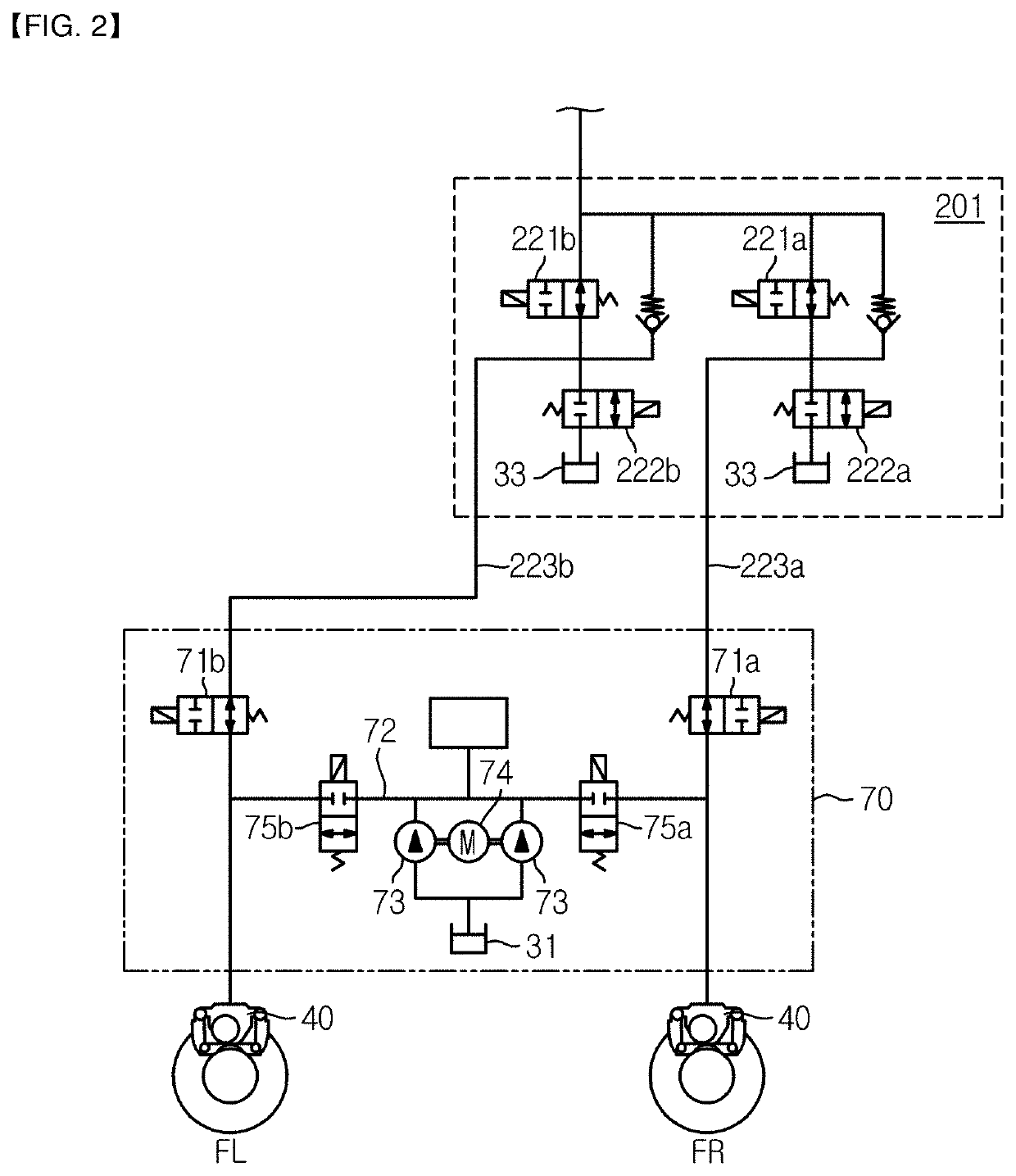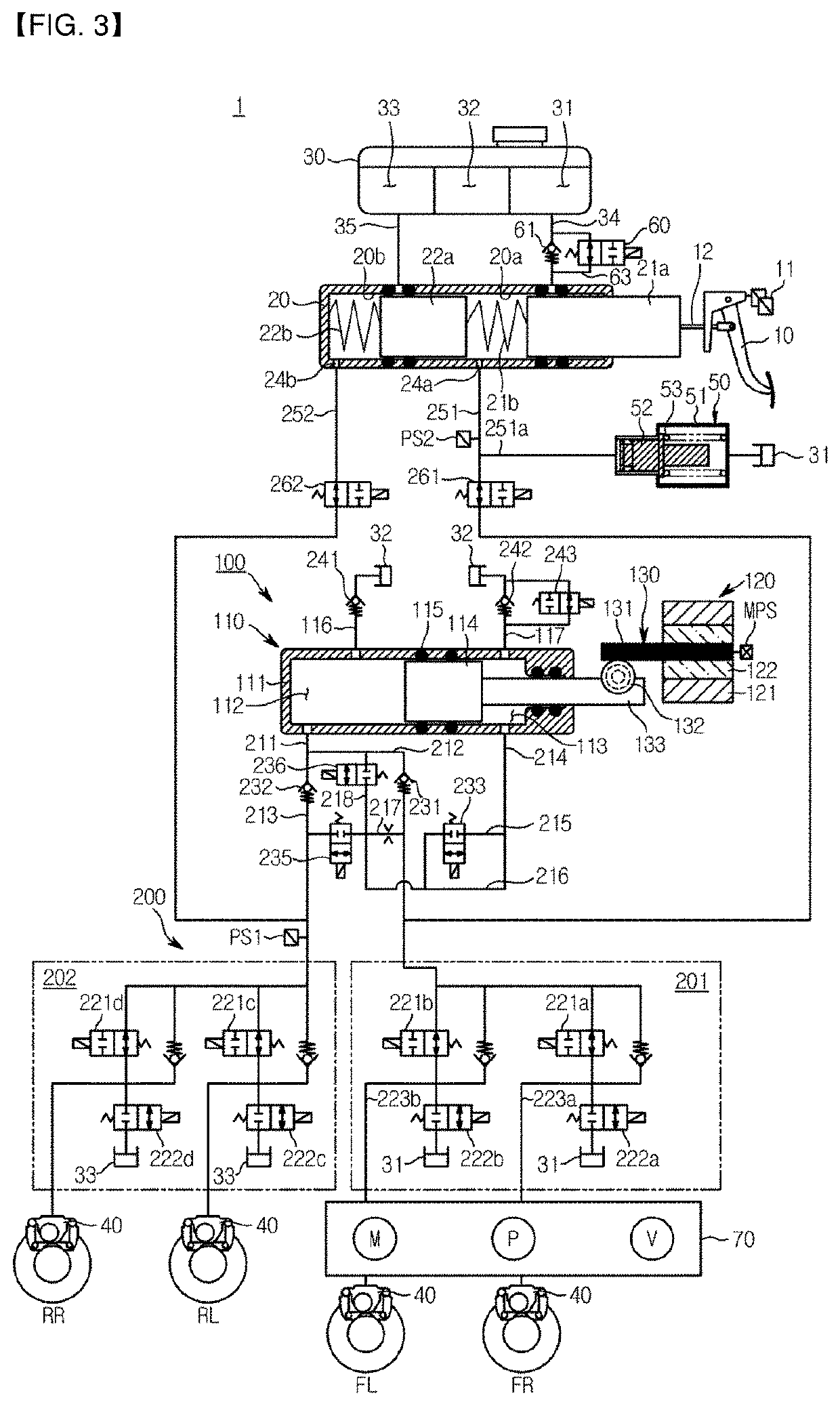Electric brake system
a technology of electric brakes and brake pedals, applied in the direction of brake systems, vehicle sub-unit features, braking components, etc., can solve the problem of requiring a significant brake pedal force from the driver, and achieve the effect of effective emergency braking
- Summary
- Abstract
- Description
- Claims
- Application Information
AI Technical Summary
Benefits of technology
Problems solved by technology
Method used
Image
Examples
first embodiment
[0037]FIG. 1 is a hydraulic circuit diagram showing a non-braking state of an electronic brake system according to the present disclosure.
[0038]Referring to FIG. 1, an electronic brake system 1 typically includes a master cylinder 20 for generating a hydraulic pressure, a reservoir 30 coupled to an upper portion of the master cylinder 20 to store oil, an input rod 12 for pressing the master cylinder 20 in accordance with a pedal effort of the brake pedal 10, wheel cylinders 40 that receive the hydraulic pressure and perform braking of each of wheels FL, RR, RL, and FR, a pedal displacement sensor 11 for sensing the displacement of the brake pedal 10, and a simulation apparatus 50 for providing a reaction force in accordance with the pedal effort of the brake pedal 10.
[0039]The master cylinder 20 may be configured to include at least one chamber to generate hydraulic pressure. As an example, the master cylinder 20 may include a first master chamber 20a and a second master chamber 20b...
second embodiment
[0198]Referring to FIGS. 3 and 4, in the electronic brake system according to the present disclosure, a branch passage 251a provided with the pedal simulator may be directly connected to the first backup passage 251 and the reservoir 30 at any time without an electronic valve intervention.
[0199]By performing the fallback function of the redundancy control apparatus 70, the simulator valve 54 provided in the branch passage 251a of the electronic brake system according to the first embodiment of the present disclosure and the simulator check valve 55 connected to the simulator valve 54 in parallel are unnecessary. Therefore, the branch passage 251a may be directly connected to the first backup passage 251 and the reservoir 30 without an electronic valve intervention.
[0200]The operation of the pedal simulation apparatus 50 in the electronic brake system according to the second embodiment of the present disclosure will be described. when the driver provides the pedal effort to the brake...
third embodiment
[0202]Referring to FIGS. 5 and 6, in the electronic brake system according to the present disclosure, the first reservoir passage 34 may be directly connected to the reservoir 30 and the master cylinder 20 without an electronic valve intervention.
[0203]The redundancy control apparatus 70 performs the fallback function so that the inspection mode performed in the electronic brake system according to the first embodiment of the present disclosure is unnecessary. Therefore, the inspection valve 60, the check valve 61, and the bypass passage 63 provided in the first reservoir flow passage 34 may be eliminated for the inspection mode. That is, it is not necessary to check the leakage of the simulator valve 54 and the stuck failure of the second piston 22a of the master cylinder 20 because the redundancy control apparatus 70 performs the fallback function, so that the first reservoir passage 34 may be directly connected to the reservoir 30 and master cylinder 20 without an electronic valv...
PUM
 Login to View More
Login to View More Abstract
Description
Claims
Application Information
 Login to View More
Login to View More - R&D
- Intellectual Property
- Life Sciences
- Materials
- Tech Scout
- Unparalleled Data Quality
- Higher Quality Content
- 60% Fewer Hallucinations
Browse by: Latest US Patents, China's latest patents, Technical Efficacy Thesaurus, Application Domain, Technology Topic, Popular Technical Reports.
© 2025 PatSnap. All rights reserved.Legal|Privacy policy|Modern Slavery Act Transparency Statement|Sitemap|About US| Contact US: help@patsnap.com



